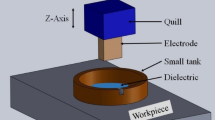Abstract
This work presents a comparative study on the performance of three types of dielectrics at different electrical discharge machining (EDM) parameter combinations favorable for generating porosity. The characteristics of the porosity formation in the recast layer formed in water/oil emulsions (W/O) were investigated by comparing them with those present in the recast layer formed in kerosene and deionized water dielectric. The results showed that the porosity characters were influenced significantly by the dielectric type. The formation mechanism of the porosity in different dielectrics is presented in this article.









Similar content being viewed by others

References
Y.S. Liao, J.T. Huang, Y.H. Chen, and J. Mater: Process. Technol., 2004, vol. 149, pp. 165–71.
H. Ramasawmy, K. Stout, and L. Blunt: Surf. Eng., 2000, vol. 16, pp. 501–05.
B. Ekmekci: Metall. Mater. Trans. B Process Metall. Mater. Process Sci., 2009, vol. 40, pp. 70–81.
O.O. Popoola, M.J. Zaluzec, and L. Haack: Surf. Eng., 1999, vol. 15, no. 6, pp. 329–34.
B. Ekmekci: Appl. Surf. Sci., 2007, vol. 253, pp. 9234–40.
Y.H. Guu: Appl. Surf. Sci., 2005, vol. 242, pp. 245–50.
M. Bayramoglu and A.W. Duffill: Surf. Eng., 2003, vol. 19, no. 5, pp. 70–74.
Y. Zhang, Y. Liu, R. Ji, and B. Cai: Appl. Surf. Sci., 2011, vol. 257, pp. 5989–97.
J.A. McGeough and H. Rasmussen: Int. J. Mach. Tool Design Res., 1982, vol. 22, pp. 333–39.
T.M.T. Shervani, A. Abdullah, and M.R. Shabgard: Eng. Anal. Boundary Elem., 2006, vol. 30, pp. 503–14.
M. Kunieda, B. Lauwers, K.P. Rajurkar, and B.M. Schumacher: CIRP Ann. Manuf. Technol., 2005, vol. 54, pp. 599–622.
X. Yang, J. Guo, X. Chen, and M. Kunieda: Precis. Eng., 2011, vol. 35, pp. 51–57.
H. Takeuchi and M. Kunieda: ISEM, 2007, pp. 63–68.
R.A. Hardin and C. Beckermann: Metall. Mater. Trans. A, 2007, vol. 38A, pp. 2992–3006.
P.K. Deshpande and R.Y. Lin: Mater. Sci. Eng. A, 2006, vol. 418, pp. 137–45.
A.A. Hamid, P.K. Ghosh, S.C. Jain, and S. Ray: Wear, 2006, vol. 260, pp. 368–78.
A. Kulkarni, J. Gutleber, S. Sampath, A. Goland, W.B. Lindquist, H. Herman, A.J. Allen, and B. Dowd: Mater. Sci. Eng. A, 2004, vol. 369, pp. 124–37.
Q. Chen, D.Y. Li, and B. Cook: Wear, 2009, vol. 267, pp. 1153–59.
F.N. Leão and I.R. Pashby: J. Mater. Process. Technol., 2004, vol. 149, pp. 341–46.
M. Cui: Mech. Manage. Dev., 2009, vol. 24, pp. 62–63.
X. Cao, M. Jahazi, J.P. Immarigeon, and W. Wallace: J. Mater. Process. Technol., 2006, vol. 171, pp. 188–204.
V.R. Raghavan and H. Martin: Chem. Eng. Process., 1995, vol. 34, pp. 439–46.
G. Cusanelli, W.A. Hessler, F. Bobard, R. Demellayer, R. Perez, and R. Flukiger: J. Mater. Process. Technol., 2004, vol. 149, pp. 289–95.
Acknowledgments
The work is supported partially by a grant from Chinese National Natural Science Foundation (Grant No. 50675225) and a grant from Department of Science & Technology of Shandong Province (Grant No. 2006GG2204001).
Author information
Authors and Affiliations
Corresponding author
Additional information
Manuscript submitted September 25, 2011.
Rights and permissions
About this article
Cite this article
Zhang, Y., Liu, Y., Ji, R. et al. Influence of Dielectric Type on Porosity Formation on Electrical Discharge Machined Surfaces. Metall Mater Trans B 43, 946–953 (2012). https://doi.org/10.1007/s11663-012-9653-3
Published:
Issue Date:
DOI: https://doi.org/10.1007/s11663-012-9653-3


